

Audrey Hepburn. Audrey Hepburn (born Audrey Kathleen Ruston; 4 May 1929 – 20 January 1993) was a British actress and humanitarian.

Recognised as a film and fashion icon, Hepburn was active during Hollywood's Golden Age. She was ranked by the American Film Institute as the third greatest female screen legend in the history of American cinema and has been placed in the International Best Dressed List Hall of Fame. She is also regarded by some to be the most naturally beautiful woman of all time.[1][2][3][4] Lewis Hine. Lewis Wickes Hine (September 26, 1874 – November 3, 1940) was an American sociologist and photographer.

Hine used his camera as a tool for social reform. His photographs were instrumental in changing the child labor laws in the United States.[1] Early life[edit] Lewis Wickes Hine was born in Oshkosh, Wisconsin in 1874. After his father died in an accident, he began working and saved his money for a college education. The classes traveled to Ellis Island in New York Harbor, photographing the thousands of immigrants who arrived each day. Documentary photography[edit] In 1906, Hine became the staff photographer of the Russell Sage Foundation.
Child laborers in glassworks. In 1908, he became the photographer for the National Child Labor Committee (NCLC), leaving his teaching position. During and after World War I, he photographed American Red Cross relief work in Europe. "Power house mechanic working on steam pump," 1920. Eddie Cochran. Cochran was born in Minnesota and moved with his family to California in the early 1950s.
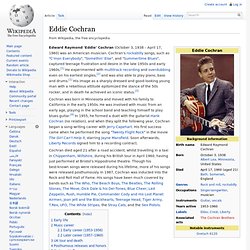
He was involved with music from an early age, playing in the school band and teaching himself to play blues guitar.[4] In 1955, he formed a duet with the guitarist Hank Cochran (no relation), and when they split the following year, Cochran began a song-writing career with Jerry Capehart. His first success came when he performed the song "Twenty Flight Rock" in the movie The Girl Can't Help It, starring Jayne Mansfield. Soon afterwards, Liberty Records signed him to a recording contract. Joseph Ducreux. Joseph, Baron Ducreux (June 26, 1735 – July 24, 1802) was a French portrait painter, pastelist, miniaturist, and engraver, who was a successful portraitist at the court of Louis XVI of France, and resumed his career after the French Revolution.

His less formal portraits show an interest in expanding the range of facial expressions beyond those of official portraiture. Life and career[edit] Born in Nancy, France, Ducreux may have trained with his father, who was also a painter. When Ducreux went to Paris in 1760, he trained as the only student of the pastelist Maurice-Quentin de La Tour, who specialized in portraiture. John Singer Sargent. John Singer Sargent (/ˈsɑrdʒənt/; January 12, 1856 – April 14, 1925) was an American artist, considered the "leading portrait painter of his generation" for his evocations of Edwardian era luxury.[1][2] During his career, he created roughly 900 oil paintings and more than 2,000 watercolors, as well as countless sketches and charcoal drawings.

His oeuvre documents worldwide travel, from Venice to the Tyrol, Corfu, the Middle East, Montana, Maine, and Florida. His parents were American, but he was trained in Paris prior to moving to London. Zdzisław Beksiński. Zdzisław Beksiński (Polish: [ˈzd͡ʑiswaf bɛkˈɕiɲski]; 24 February 1929 – 21 February 2005) was a renowned Polish painter, photographer, and sculptor.
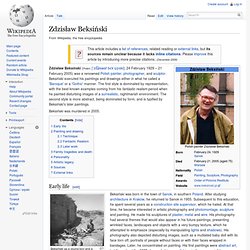
Beksiński executed his paintings and drawings either in what he called a 'Baroque' or a 'Gothic' manner. The first style is dominated by representation, with the best-known examples coming from his fantastic realism period when he painted disturbing images of a surrealistic, nightmarish environment. The second style is more abstract, being dominated by form, and is typified by Beksiński's later paintings. Piet Mondrian. Pieter Cornelis "Piet" Mondriaan, after 1906 Mondrian (/ˈmɔːndriˌɑːn, ˈmɒn-/;[1] Dutch: [ˈpit ˈmɔndrijaːn], later [ˈmɔndrijɑn]; 7 March 1872 – 1 February 1944), was a Dutch painter.
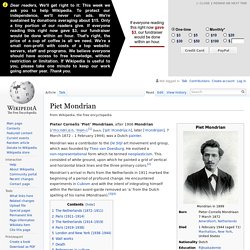
Mondrian's arrival in Paris from the Netherlands in 1911 marked the beginning of a period of profound change. He encountered experiments in Cubism and with the intent of integrating himself within the Parisian avant-garde removed an 'a' from the Dutch spelling of his name (Mondriaan).[3][4] The Netherlands (1872–1911)[edit] In this house, now the Villa Mondriaan, in Winterswijk, Piet Mondrian lived from 1880 to 1892 Mondrian was born in Amersfoort in the Netherlands, the second of his parents' children.[5] He was descended from Christian Dirkzoon Monderyan who lived in The Hague as early as 1670.[3] The family moved to Winterswijk in the east of the country when his father, Pieter Cornelius Mondriaan, was appointed Head Teacher at a local primary school.[6] Mondrian was introduced to art from a very early age. Marcel Duchamp. Marcel Duchamp (French: [maʁsɛl dyʃɑ̃]; 28 July 1887 – 2 October 1968) was a French-American painter, sculptor, chess player, and writer whose work is associated with Dadaism[1][2] and conceptual art,[3] although not directly associated with Dada groups.
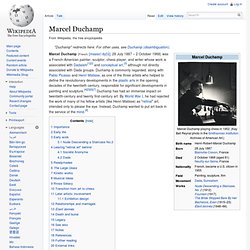
Duchamp is commonly regarded, along with Pablo Picasso and Henri Matisse, as one of the three artists who helped to define the revolutionary developments in the plastic arts in the opening decades of the twentieth century, responsible for significant developments in painting and sculpture.[4][5][6][7] Duchamp has had an immense impact on twentieth-century and twenty first-century art.
Hendrix-1.jpg (JPEG Image, 302 × 400 pixels) Vladimir Nabokov. Vladimir Vladimirovich Nabokov (Russian: Влади́мир Влади́мирович Набо́ков, pronounced [vlɐˈdʲimʲɪr nɐˈbokəf] ( ), also known by the pen name Vladimir Sirin; 22 April [O.S. 10 April] 1899c – 2 July 1977) was a Russian-American novelist.[1] Nabokov's first nine novels were in Russian.
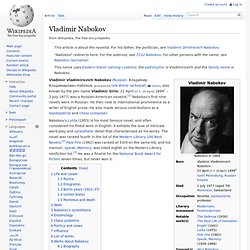
He then rose to international prominence as a writer of English prose. He also made serious contributions as a lepidopterist and chess composer. George Boole. George Boole (/ˈbuːl/; 2 November 1815 – 8 December 1864) was an English mathematician, philosopher and logician.
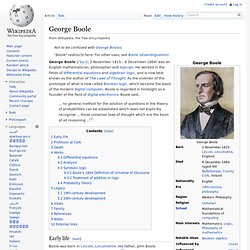
He worked in the fields of differential equations and algebraic logic, and is now best known as the author of The Laws of Thought. As the inventor of the prototype of what is now called Boolean logic, which became the basis of the modern digital computer, Boole is regarded in hindsight as a founder of the field of digital electronics. Grace Hopper. Early life and education[edit] Hopper was born Grace Brewster Murray in New York City. She was the oldest in a family of three children. She was curious as a child, a lifelong trait; at the age of seven she decided to determine how an alarm clock worked, and dismantled seven alarm clocks before her mother realized what she was doing (she was then limited to one clock).[9] For her preparatory school education, she attended the Hartridge School in Plainfield, New Jersey.
Rejected for early admission to Vassar College at age 16 (her test scores in Latin were too low), she was admitted the following year. Pierre Charles L'Enfant. Pierre "Peter" Charles L'Enfant (French: [pjɛʁ ʃɑʁl lɑ̃fɑ̃]; August 9, 1754 – June 14, 1825) was a French-born American architect and civil engineer best known for designing the layout of the streets of Washington, D.C., the L'Enfant Plan. Early life and education[edit] Career[edit] Military service[edit] William Stewart Halsted. Yellapragada Subbarao. George Minot. George Richards Minot (December 2, 1885 – February 25, 1950) was an American medical researcher who shared the 1934 Nobel Prize with George Hoyt Whipple and William P. Murphy for their pioneering work on pernicious anemia. Rudolf Virchow. Philippe Halsman. Philippe Halsman self-portrait. Philippe Halsman (Russian: Филипп Халсман; Latvian: Filips Halsmans; 2 May 1906 – 25 June 1979 New York City) was an American portrait photographer born in Riga in the part of the Russian Empire which later became Latvia.
Comte de Lautréamont. Marcus Aurelius. Roman emperor from 161 to 180, philosopher Roman emperor Marcus Aurelius Antoninus ( ə-REE-lee-əs;[2] Latin: [ˈmaːrkʊs̠ au̯ˈreːlijʊs̠ an̪t̪oːˈniːnʊs̠]; 26 April 121 – 17 March 180) was Roman emperor from 161 to 180 and a Stoic philosopher. He was the last of the rulers known as the Five Good Emperors (a term coined some 13 centuries later by Niccolò Machiavelli), and the last emperor of the Pax Romana (27 BC to 180), an age of relative peace and stability for the Roman Empire. Friedrich Nietzsche. Edmund Hillary. Tenzing Norgay. Quintilian. Alan Turing. Alan Mathison Turing, OBE, FRS (/ˈtjʊərɪŋ/ TEWR-ing; 23 June 1912 – 7 June 1954) was a British mathematician, logician, cryptanalyst, philosopher, pioneering computer scientist, mathematical biologist, and marathon and ultra distance runner.
He was highly influential in the development of computer science, providing a formalisation of the concepts of "algorithm" and "computation" with the Turing machine, which can be considered a model of a general purpose computer.[2][3][4] Turing is widely considered to be the father of theoretical computer science and artificial intelligence.[5] During World War II, Turing worked for the Government Code and Cypher School (GC&CS) at Bletchley Park, Britain's codebreaking centre.
For a time he led Hut 8, the section responsible for German naval cryptanalysis. After the war, he worked at the National Physical Laboratory, where he designed the ACE, among the first designs for a stored-program computer. Early life and career[edit]